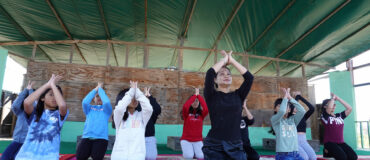By Michelle Lynch Reynolds
Advocacy has long been one of those big, broad words whose definition I knew in theory, but I’d never experienced face-to-face advocacy firsthand to gain true insight into its meaning — and outcomes. In imagining what my first governmental advocacy meetings might be like, I wondered: How could I be the most effective voice in representing a diverse field of artists? Do I need to be an expert on the issues? Ultimately, what sort of impact can I make?
Each year, Americans for the Arts organizes, and Dance/USA serves as a National Co-Sponsor for, Arts Advocacy Day, which “brings together a broad cross section of America’s cultural and civic organizations … to Washington, D.C., to meet with their members of Congress in support of issues like arts education policy, the charitable tax deduction, and funding for the National Endowment for the Arts.” And for many of those years, Dancers’ Group — the primary dance service organization in the San Francisco Bay Area — has sent our executive director Wayne Hazzard to Washington, D.C., to participate.
Hazzard writes: “After participating in Arts Advocacy Day in Washington, D.C., for six years I was eager to see how Dancers’ Group might complement the annual event by holding a simultaneous gathering of dance artists and administrators in San Francisco. Plus, there’s the fact that the D.C. gathering is open to all disciplines and I was interested in focusing in on representing a strong and diverse dance voice that could talk about issues specific to our work. And, not to sound cheap, I didn’t have to pay to fly somewhere to meet with my national and local representatives.”
So we at Dancers’ Group set about developing what we dubbed as Dance Advocacy Day. Timed and modeled after the national version, it featured meetings set up with staffers from our state and congressional representatives’ local offices, and an open call for anyone in the Bay Area dance community to join in, free of charge.

Photo by Rosa Lisbeth Navarrete
Our hopes in organizing Dance Advocacy Day, which coincides with Arts Advocacy Day in Washington, D.C., each spring, are two-fold. First, it is a way for us to be involved in advocating for the local dance community on both the national level with visits to the offices of our member of Congress, Nancy Pelosi, and our senators, Dianne Feinstein and Barbara Boxer — as well as with our state-level representatives. With our state representatives, we are able to talk about specific, and very important issues unique to our region that fall outside the purview of the federal government. With our state representatives, we are able to talk about specific, and
very important issues unique to our region that fall outside the purview
of the federal government. This year, for example, we were able to have in-depth discussions about the rise of housing prices in the Bay Area, and upcoming legislation around evictions and tenants’ rights.
Secondly, Dance Advocacy Day is a way for us to connect the Dancers’ Group community to the advocacy process, and encourage advocacy activity, not just on that particular day, but anytime, all year round. By bringing the meetings to our region, we hope to lower the barrier to entry, and help demonstrate that advocacy is accessible — and empowering — for anyone.
While I’ve long been interested in politics, and regularly keep up on the news, I don’t consider myself an expert, or even close to one, on any issue. So I first found the idea of talking about arts issues and leading a meeting with a group of dedicated artists and administrators, plus a governmental staffer, daunting to say the least. However, Dance/USA and Arts Advocacy Day partners update issue briefs each year (available online for free at danceusa.org/key-advocacy-issues) and they are helpful in breaking down the issues for both the beginner advocate and something you can give the staffers at meetings. They are hugely helpful for giving you the figures and the talking points; they do the research for you, and you get to carry around the briefs to quote from.
More importantly, I came to realize that the figures and talking points were a relatively small part of each meeting. When we shared personal stories and brought to life the vibrant work going on, including struggles and issues for each dance entity then the staffers were most responsive. For example, in our recent meetings, one of our participants, Charles Slender, the artistic director of the contemporary dance company FACT/SF, shared his experience receiving support from the U.S. State Department to undertake a three-month tour of Russia. He spoke of the personal experience working with Russians in workshops and performances, and the impact that his cultural diplomacy had for him, his organization and those who he worked with in Russia. This one story helped to illuminate our discussion of the issue of funding for cultural exchange grants through the State Department. We’ve all heard speeches given by politicians where they draw on personal stories of their constituents; we have now provided a handful of stories about the value and impact of dance for our legislators to pull from if and when the time comes.
Stories like Slender’s also helped answer my question of how to represent an entire field, which is, quite simply, that you don’t. Or rather, not entirely. Even in a group meeting, individual personal stories and experiences help illustrate how issues can impact the larger community. That’s not to say that you wouldn’t want to gather and use the impressive statistics about the larger field that you work within — for example there are more than 800 dance entities working in the San Francisco Bay Area, and we are the largest per capita dance community in the nation — but you shouldn’t feel pressured to try to represent everyone. This year, as a group of 13, we found ourselves to be quite a diverse bunch, with artists from a range of disciplines and organizations across a spectrum of sizes and structures. We capitalized on that diversity, collectively being able to represent and give voice to a significant percentage of the dance sector of our region by telling our individual stories.
There are also some perks that can come from advocacy meetings. Last year, for example, we were offered a proclamation signed by Rep. Nancy Pelosi for Dancers’ Group work in presenting the annual Bay Area Dance Week, as well as a letter from her acknowledging the strong work of our 2013 Dancers Choice Award winner, Sarah Crowell, a long-time educator and teacher based in Oakland, California. This year, we got tips for how to invite representatives to our performances and events and which activities they might be most interested in attending.
In the San Francisco Bay Area, we met with staffers of representatives who already support flagship arts issues — who support the value of arts education and have a history of voting to fund the National Endowment for the Arts, etc. We (luckily) weren’t in the position to have to try and sway anyone about supporting dance and the arts. We were, however, able to take the opportunity to educate staffers on the broad range of issues that impact the dance field, whether it’s about increased NEA funding, preserving the charitable tax deduction or funding international cultural exchange. Given the context of friendly meetings with like-minded staffers, and following our recent Dance Advocacy Day, one participant reflected: “I will admit to having left the day wondering whether our visits would actually have any impact.”
Following the meetings, both last year and this year, I now have a far more tangible definition of what advocacy can be, and I can begin to see what results of its impact. Advocacy means making yourself visible as an artist, a representative of an organization, a representative of a field and a voter, and alerting or reminding your representatives about the issues that impact your life and work and the health of your sector. In a political landscape where many industries have scores of lobbyists knocking at politicians’ doors day after day to support them, the arts, and dance in particular, do not have nearly enough human resources. So, advocacy through in-person meetings is one simple, no-cost way of staying visible.
Interested in arts advocacy? Scheduling meetings with representatives or their staffers is a straightforward process, and is the same for an individual or group. Some representatives have clear instructions on how to schedule a meeting directly on their website, but if they don’t, everyone has a phone number for their office(s). A quick call to their offices, and you can find out what the process is to schedule a meeting; it’s typically either through an email request or a form template that they can send you. I recommend reaching out to schedule your meeting(s) two-three weeks in advance.
For Dancers’ Group’s 2014 Dance Advocacy, which took place on Tuesday, March 25, we gathered a fantastic cohort of local dance artists and administrators, through an open email call. We’d like to thank all of those who participated:
- Sharon Benitez, Arts Administration Fellow, Dancers’ Group
- Shae Colett, Outreach Director, Dancers’ Group
- Aleta Hayes, Artistic Director, Chocolate Heads Movement Band and Lecturer, Stanford University
- Michelle Iki, Intern, San Francisco Dance Film Festival
- Sausan Molthen, Master teacher/choreographer, Sausan Academy of Egyptian Dance
- Robin Nasatir, Board Treasurer, Dancers’ Group
- Rosa Lisbeth Navarette, Program Assistant, Dancers’ Group
- Farah Yasmeen Shaikh, dancer and teacher, Chitresh Das Dance Company
- Charles Slender, Artistic Director, FACT/SF
- Nadhi Thekkek, Artistic Director, Nava Dance Theater
- Brian Wiedenmeier, Institutional Giving Director, ODC
- Katerina Wong, independent dancer
 Michelle Lynch Reynolds is program director of Dancers’ Group. She held the position of senior development associate with the Bay Area arts fundraising firm of Quinn Associates and has been a fellow with the San Francisco Bay Area Emerging Arts Professionals, where she is now part of the Leadership Team. She holds a BA in dance and international studies from Goucher College in Baltimore and an MA in Dance Theatre: the Body in Performance from the Trinity Laban Conservatoire of Music and Dance in London.
Michelle Lynch Reynolds is program director of Dancers’ Group. She held the position of senior development associate with the Bay Area arts fundraising firm of Quinn Associates and has been a fellow with the San Francisco Bay Area Emerging Arts Professionals, where she is now part of the Leadership Team. She holds a BA in dance and international studies from Goucher College in Baltimore and an MA in Dance Theatre: the Body in Performance from the Trinity Laban Conservatoire of Music and Dance in London.
Dancers’ Group is the primary dance service organization of the San Francisco Bay Area (SFBA), home to the second largest, and arguably most diverse, dance community in the country. DG’s mission is to promote the visibility and viability of dance, and it serves SFBA artists, the dance community, and its audiences.
____
We accept submissions on topics relevant to the field: advocacy, artistic issues, arts policy, community building, development, employment, engagement, touring, and other topics that deal with the business of dance. We cannot publish criticism, single-company season announcements, and single-company or single artist profiles. Additionally, we welcome feedback on articles. If you have a topic that you would like to see addressed or feedback, please contact communications@danceusa.org.
Disclaimer: Opinions expressed in guest posts do not necessarily represent the viewpoints of Dance/USA.




